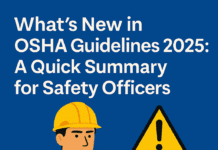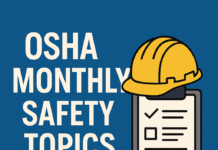
OSHA Exam Questions and Answers
Introduction to OSHA Exam
Workplace safety is paramount for both employers and employees. The Occupational Safety and Health Administration (OSHA) plays a crucial role in ensuring safe working environments across various industries. OSHA exams are designed to assess compliance with safety regulations and identify potential hazards that could jeopardize the well-being of workers.
Purpose of OSHA Exams
The primary objective of OSHA exams is to uphold workplace safety standards. By conducting regular inspections and examinations, OSHA aims to mitigate risks and prevent accidents and injuries in the workplace. Compliance with OSHA regulations is not only a legal requirement but also a moral obligation to safeguard the health and well-being of employees.
Types of OSHA Exams
OSHA exams are tailored to specific industries to address sector-specific risks adequately. For instance, there are separate exams for the general industry and the construction industry. These exams cover a wide range of topics, including electrical safety, hazardous materials handling, and fall protection.
Frequency of OSHA Exams
The frequency of OSHA exams varies depending on several factors, including the industry type, the size of the workforce, and the history of safety violations. While some businesses may undergo regular inspections as part of their compliance routine, others may face exams due to specific incidents or complaints.
OSHA Exam Format
OSHA exams typically involve a combination of written tests and on-site inspections. Written tests assess theoretical knowledge of safety protocols and regulations, while on-site inspections evaluate practical implementation and adherence to these standards.
Common OSHA Exam Questions
During OSHA exams, inspectors may ask a variety of questions to assess the level of compliance and identify potential areas of improvement. Some common topics include safety protocols, hazard identification, emergency procedures, and proper use of personal protective equipment (PPE).
What does OSHA stand for?
Answer: Occupational Safety and Health Administration
What is the primary goal of OSHA?
Answer: The primary goal of OSHA is to ensure safe and healthful working conditions for employees by setting and enforcing standards and by providing training, outreach, education, and assistance.
What are the key elements of an effective safety and health management system according to OSHA?
Answer: The key elements include management leadership and employee involvement, worksite analysis, hazard prevention and control, and safety and health training.
What are the rights of workers under OSHA?
Answer: Workers have the right to a safe workplace, the right to receive training on job hazards, the right to access exposure and medical records, and the right to file a complaint with OSHA if they believe there are unsafe or unhealthy conditions in their workplace.
What are the penalties for violating OSHA standards?
Answer: Penalties for violating OSHA standards can include fines, citations, and in some cases, criminal charges.
What is the purpose of an OSHA inspection?
Answer: The purpose of an OSHA inspection is to ensure that employers are complying with OSHA standards and providing employees with safe and healthful working conditions.
What are some common workplace hazards that OSHA regulations address?
Answer: Common workplace hazards include falls, chemical exposures, electrical hazards, confined spaces, and ergonomic hazards.
What is the difference between an OSHA regulation and an OSHA standard?
Answer: An OSHA regulation is a broad requirement that employers must follow to protect workers from hazards, while an OSHA standard is a specific requirement that addresses a particular hazard or aspect of workplace safety.
What is the purpose of the OSHA 300 Log?
Answer: The OSHA 300 Log is used to record and track work-related injuries and illnesses in the workplace. It helps employers, employees, and OSHA identify trends in workplace safety and health and develop strategies for prevention.
What is the difference between an OSHA citation and a hazard alert letter?
Answer: An OSHA citation is issued when an employer is found to be in violation of OSHA standards or regulations. It may include penalties and corrective actions that the employer must take. A hazard alert letter is issued to inform employers and employees about a particular hazard or unsafe condition in the workplace identified during an inspection, but it does not carry penalties.
When should employers provide training to employees under OSHA standards?
Answer: Employers should provide training to employees when they are first hired, when new hazards are introduced into the workplace, and when there are changes in OSHA standards or regulations that affect their job duties.
What are some examples of personal protective equipment (PPE) that employers may be required to provide under OSHA standards?
Answer: Examples of PPE include safety glasses, gloves, hard hats, hearing protection, respirators, and fall protection equipment.
What is the purpose of OSHA’s Hazard Communication Standard (HCS)?
Answer: The Hazard Communication Standard (HCS) requires employers to provide information to employees about hazardous chemicals in the workplace through labels, safety data sheets (SDSs), and training programs. Its purpose is to ensure that employees are aware of the hazards associated with the chemicals they work with and know how to protect themselves.
What should employers do if an employee reports a workplace hazard or safety concern?
Answer: Employers should take the report seriously, investigate the hazard or safety concern promptly, and take appropriate actions to address and correct the hazard to prevent injuries or illnesses.
What resources are available to employers for OSHA compliance assistance?
Answer: Employers can access a variety of resources for OSHA compliance assistance, including OSHA’s website, publications, training materials, consultation services, and alliances with industry groups and trade associations.
What is the purpose of OSHA’s Respiratory Protection Standard?
Answer: The Respiratory Protection Standard establishes guidelines for employers to protect employees from exposure to respiratory hazards in the workplace. It requires employers to provide appropriate respiratory protection, conduct medical evaluations, fit testing, and training for employees who are required to use respirators.
What steps should employers take to prevent workplace accidents and injuries?
Answer: Employers should implement effective safety and health programs, identify and eliminate hazards through regular inspections, provide proper training to employees, enforce safety rules and procedures, and encourage employee participation in safety activities.
What are the requirements for reporting work-related injuries and illnesses to OSHA?
Answer: Employers must report work-related fatalities within 8 hours and work-related in-patient hospitalizations, amputations, or losses of an eye within 24 hours to OSHA.
What is the role of the Occupational Safety and Health Review Commission (OSHRC)?
Answer: The Occupational Safety and Health Review Commission (OSHRC) is an independent federal agency that adjudicates disputes arising from OSHA citations. It conducts hearings and renders decisions on contested citations and penalties issued by OSHA.
How often should employers conduct safety inspections of the workplace?
Answer: Employers should conduct regular safety inspections of the workplace to identify hazards and ensure compliance with OSHA standards. The frequency of inspections may vary depending on the type of industry, the size of the workplace, and the nature of the hazards present.
What is the purpose of OSHA’s General Duty Clause?
Answer: The General Duty Clause requires employers to provide a workplace that is free from recognized hazards that are causing or likely to cause death or serious physical harm to employees, even if there is no specific OSHA standard addressing the hazard.
What are the requirements for recording work-related injuries and illnesses on the OSHA 300 Log?
Answer: Employers must record all work-related injuries and illnesses that result in death, days away from work, restricted work activity, or medical treatment beyond first aid on the OSHA 300 Log.
Preparing for OSHA Exams
Proper preparation is essential to succeed in OSHA exams. Employers can invest in comprehensive training programs for their employees to ensure they are well-versed in safety regulations and protocols. Conducting mock exams can also help identify weaknesses and address them before the actual inspection.
Importance of OSHA Certification
Obtaining OSHA certification not only demonstrates a commitment to workplace safety but also enhances the credibility of an organization. Certified workplaces are more likely to attract customers and investors who prioritize safety and ethical business practices.
Benefits of OSHA Compliance
Compliance with OSHA regulations offers numerous benefits beyond avoiding fines and penalties. It fosters a safer work environment, reduces the risk of accidents and injuries, and boosts employee morale and productivity. Ultimately, OSHA compliance is a win-win situation for both employers and employees.
Challenges in OSHA Compliance
While OSHA compliance is essential, it can pose challenges for businesses, particularly small and medium-sized enterprises (SMEs). Compliance costs, bureaucratic red tape, and the complexity of regulations are some of the hurdles that organizations may encounter on their journey towards maintaining a safe workplace.
Common OSHA Violations
Despite efforts to comply with regulations, some businesses may inadvertently violate OSHA standards due to oversight or negligence. Common violations include inadequate fall protection measures, improper hazard communication, and lack of proper training for employees working with hazardous materials.
Consequences of OSHA Violations
OSHA violations can have serious consequences for businesses, ranging from hefty fines and penalties to reputational damage and legal liabilities. In addition to financial implications, violations may result in workplace accidents and injuries, tarnishing the company’s image and eroding trust among stakeholders.
Conclusion
In conclusion, OSHA exams are instrumental in promoting workplace safety and ensuring compliance with regulatory standards. By investing in proper training, resources, and a culture of safety, businesses can not only pass OSHA exams with flying colors but also create a safer and healthier work environment for their employees.
List of OSHA Standards for Safety
Occupational Safety and Health Administration
HSE Training Requirements in OSHA Standards
FAQs (Frequently Asked Questions)
- How often does OSHA conduct inspections?
- OSHA conducts inspections regularly, with the frequency varying based on factors such as industry type and compliance history.
- What should I do if my workplace fails an OSHA exam?
- If your workplace fails an OSHA exam, take immediate steps to address any identified deficiencies and implement corrective actions to prevent future violations.
- Can OSHA inspections be scheduled in advance?
- While OSHA inspections are typically unannounced, some inspections may be scheduled in advance for specific reasons, such as follow-up visits or targeted enforcement actions.
- Are there any exemptions from OSHA regulations?
- Some industries may be partially exempt from certain OSHA regulations based on their classification or specific activities. However, exemptions are limited, and most businesses are subject to OSHA oversight.
- How can I stay updated with changes in OSHA regulations?
- To stay informed about changes in OSHA regulations, regularly check the official OSHA website, subscribe to industry newsletters, and participate in relevant training programs and seminars.

























Thanks sir 👍
Hi,Are there any particular tests for school environment and education industries.
Thanks